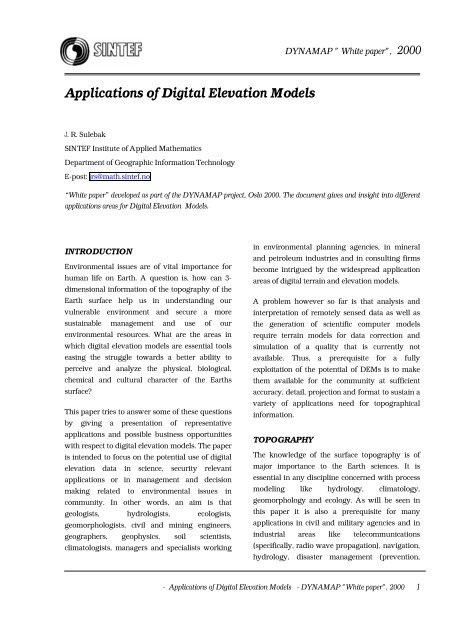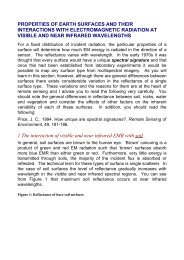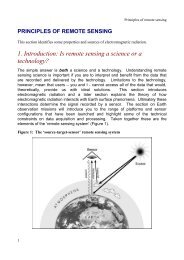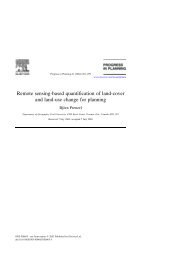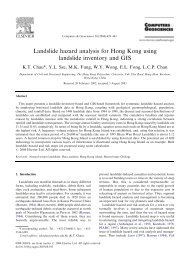Applications of Digital Elevation Models
Applications of Digital Elevation Models
Applications of Digital Elevation Models
Create successful ePaper yourself
Turn your PDF publications into a flip-book with our unique Google optimized e-Paper software.
DYNAMAP " White paper", 2000<strong>Applications</strong> <strong>of</strong> <strong>Digital</strong> <strong>Elevation</strong> <strong>Models</strong>J. R. SulebakSINTEF Institute <strong>of</strong> Applied MathematicsDepartment <strong>of</strong> Geographic Information TechnologyE-post: jrs@math.sintef.no“White paper” developed as part <strong>of</strong> the DYNAMAP project, Oslo 2000. The document gives and insight into differentapplications areas for <strong>Digital</strong> <strong>Elevation</strong> <strong>Models</strong>.INTRODUCTIONEnvironmental issues are <strong>of</strong> vital importance forhuman life on Earth. A question is, how can 3-dimensional information <strong>of</strong> the topography <strong>of</strong> theEarth surface help us in understanding ourvulnerable environment and secure a moresustainable management and use <strong>of</strong> ourenvironmental resources. What are the areas inwhich digital elevation models are essential toolseasing the struggle towards a better ability toperceive and analyze the physical, biological,chemical and cultural character <strong>of</strong> the Earthssurface?This paper tries to answer some <strong>of</strong> these questionsby giving a presentation <strong>of</strong> representativeapplications and possible business opportunitieswith respect to digital elevation models. The paperis intended to focus on the potential use <strong>of</strong> digitalelevation data in science, security relevantapplications or in management and decisionmaking related to environmental issues incommunity. In other words, an aim is thatgeologists, hydrologists, ecologists,geomorphologists, civil and mining engineers,geographers, geophysics, soil scientists,climatologists, managers and specialists workingin environmental planning agencies, in mineraland petroleum industries and in consulting firmsbecome intrigued by the widespread applicationareas <strong>of</strong> digital terrain and elevation models.A problem however so far is that analysis andinterpretation <strong>of</strong> remotely sensed data as well asthe generation <strong>of</strong> scientific computer modelsrequire terrain models for data correction andsimulation <strong>of</strong> a quality that is currently notavailable. Thus, a prerequisite for a fullyexploitation <strong>of</strong> the potential <strong>of</strong> DEMs is to makethem available for the community at sufficientaccuracy, detail, projection and format to sustain avariety <strong>of</strong> applications need for topographicalinformation.TOPOGRAPHYThe knowledge <strong>of</strong> the surface topography is <strong>of</strong>major importance to the Earth sciences. It isessential in any discipline concerned with processmodeling like hydrology, climatology,geomorphology and ecology. As will be seen inthis paper it is also a prerequisite for manyapplications in civil and military agencies and inindustrial areas like telecommunications(specifically, radio wave propagation), navigation,hydrology, disaster management (prevention,- <strong>Applications</strong> <strong>of</strong> <strong>Digital</strong> <strong>Elevation</strong> <strong>Models</strong> - DYNAMAP "White paper", 2000 1
DYNAMAP " White paper", 2000relief, assessment), transportation andinfrastructure planning. In a classical sense, theexpression topography is defined by the Greekwords topos and graphein referring to place andthe process <strong>of</strong> writing or describing, respectively.Topography is, therefore, a detailed study ordescription <strong>of</strong> a particular place or region. Bydescribing the elevation <strong>of</strong> each point and itsneighborhood, topography is a graphicrepresentation <strong>of</strong> landscapes natural surfacefeatures including hills, valleys, rivers, lakes andsuch, as principle man-made features. Typically,topography is drawn on maps and charts orotherwise presented.Early topographic models were made <strong>of</strong> wood,pasteboards, plaster or moulded material, mapswere, then painted by hand onto the surface <strong>of</strong> themodel. More familiar are paper maps with thetopography recorded as shaded relief, slope mapor as contour lines. The first two methods gives astrong visual effect <strong>of</strong> 3-dimension (or rely 2.5dimension) helping the reader <strong>of</strong> the map to graspthe essential characteristics <strong>of</strong> the landscapefeatures. These methods <strong>of</strong> displaying relief are,however inadequate in that they do not give anyinformation on the elevation above sea level <strong>of</strong> allpoints on the map or how steep the slopes are.Topographic contours derived fromphotogrammetry by interpreting stereo aerialphotography images give an accurate depiction <strong>of</strong>the elevation along the contours. Between thecontours however topographic contours supplyonly fairly accurate information about elevationand slopes, being derived from an interpolationbetween precisely determined reference pointsalong the contours. The elevation is also alwaysestimated to the nearest meter. The need forapproximation and generalization in topographicmaps results in great loss <strong>of</strong> detail and accuracy.Although in some circumstances the elimination<strong>of</strong> small-scale features could give valuableinformation when analyzing large-scalephenomena.Today, the techniques <strong>of</strong> radar interferometrywith Synthetic Aperture Radar systems (SAR) andlaser interferometry (LIDAR) are currently themost advanced technology and the most effectiveway <strong>of</strong> acquiring topographic information. It isindependent <strong>of</strong> cloud covers, sun illumination andthe contrast <strong>of</strong> the Earth's surface.DIGITAL ELEVATION MODELSWhen modern aerial photography and satelliteremote sensing started to provide continuossurface information by means <strong>of</strong> optical cameras,radar or laser beams, for example, and thederivation <strong>of</strong> terrain elevation was made possibleby stereoscopy and interferometry, topographygained whole new meaning in spatial studies. Ourability to perceive and analyze the physical,biological, chemical and cultural character <strong>of</strong> theEarths surface has, since, been greatly expanded.Today, the elevation information is represented incomputers as elevation data in a digital format.This format is usually called digital elevationmodels (DEM). Thus a DEM is a computerizedrepresentation <strong>of</strong> the Earths relief. Differentformats exists, among the most usual aretriangulated irregular networks (TIN), regulargrids, contour lines and scattered data points. ADEM is usually described either by a wire framemodel or an image matrix in which the value <strong>of</strong>each pixel is associated with a specific topographicheight.<strong>Digital</strong> elevation models are in combination withother spatial data, an important database fortopography-related analyses or 3D videoanimations (e.g. fly-throughs). Different- <strong>Applications</strong> <strong>of</strong> <strong>Digital</strong> <strong>Elevation</strong> <strong>Models</strong> -- DYNAMAP "White paper", 2000 2
DYNAMAP " White paper", 2000• Commercial applications• Industrial applications• Operational applications• Military applicationswhere DEMs play a significant role in theimprovement <strong>of</strong> analysis result, productdevelopment and decision making.Thus, DEM are an asset in a variety <strong>of</strong> bothcommercial and public business and managementfields within telecommunications, navigation,energy, disaster management, transportation,weather forecast, remote sensing, geodesy, landcover classification, civil engineering and manymore. The wide range <strong>of</strong> different applications inwhich DEMs will be useful reflect the overallimportance <strong>of</strong> the availability <strong>of</strong> global, consistent,high quality digital elevation models.SCIENTIFIC APPLICATIONSExact information about the Earths surface is <strong>of</strong>fundamental importance in all geosciences. Thetopography exaggerate control over range <strong>of</strong> Earthsurface processes (evaporation, water flow, massmovement, forest fires) important for the energyexchange between the physical climate system inthe atmosphere and the biogeochemical cycles atthe Earth surface. Ecology investigates thedependencies between all life forms and theirenvironment such as soil, water, climate andlandscape. Hydrology needs the knowledge aboutthe relief to model the movement <strong>of</strong> water,glaciers and ice. Geomorphology describes therelief recognizing form-building processes.Climatology investigates fluxes <strong>of</strong> temperature,moisture, air particles all influenced bytopography.• In weather forecast and climate modeling,models <strong>of</strong> conversion processes between theground and the atmosphere as well as <strong>of</strong>movements in the lower atmospheric strataalso rely on uniform and global DEMs.Relationship between the topography and theshape <strong>of</strong> the land surface with a variety <strong>of</strong>state variables <strong>of</strong> geo-processes likeevaporation, run<strong>of</strong>f, soil moisture, influencingthe climate in local and global scale.Another area <strong>of</strong> application is a global land coverclassification. Precise mapping and classification<strong>of</strong> the Earth's surface at a global scale is the mostimportant prerequisite for large-scale modeling <strong>of</strong>geo-processes. In numerous studies, it wasdemonstrated that radar images are suitable fordocumentation and classification <strong>of</strong> naturalvegetation and agricultural areas. In remotesensing DEMs are used together with GIS tocorrect images or retrieve thematic informationwith respect to sensor geometry and local relief toproduce geocoded products. Thus, for thesynergic use <strong>of</strong> different sensor systems (and GIS),digital elevation model are a prerequisite forgeocoding satellite images and correcting terraineffects in radar scenes.To summarize, the science community, forexample, employs DEMs for research on• Climate impact studies• Water and wildlife management• Geological and hydrological modeling• Geographic information technology• Geomorphology and landscape analysis• Mapping purposes and• Educational programs- <strong>Applications</strong> <strong>of</strong> <strong>Digital</strong> <strong>Elevation</strong> <strong>Models</strong> -- DYNAMAP "White paper", 2000 4
DYNAMAP " White paper", 2000COMMERCIAL APPLICATIONSCommercial applications are more marked andbusiness oriented applications related to sale anddistribution <strong>of</strong> DEM and DEM products. From thispoint <strong>of</strong> view, two main market sectors areinterested in digital terrain models. One sectoremploys basic DEM products where data arepreprocessed and geocoded but have noapplication associated with them. The other sectorencompasses the value-adding services, whichcouple DEMs with a specific application. Thefollowing overview for both sectors addressesquestions likeIs there a market for digital elevation models?Do the users know the available products?Are there any competitors on the market?Commercial providers <strong>of</strong>fer DEMs or DEM –associated products, which are <strong>of</strong> interests forissues in• Telecommunication• Air traffic routing and navigation• Planning and construction• Geological exploration• Hydrological and meteorological services• Geokoding <strong>of</strong> remote sensing and• Market <strong>of</strong> multimedia applications andcomputer gamesBasic DEM productsNew opportunities for generating digital elevationmodels are given by new technology in remotesensing to measure elevation at the Earth surfaceat increasing resolution for larger areas. Anexample is the X-SAR/STRM Shuttle RadarTopography Mission that gives a digital elevationdata at 30m resolution covering 80% <strong>of</strong> the Earthsurface. Several studies where carried out for theEuropean Union, for the European Space Agencyand by the Euroimage Consortium. All studiesconfirm that there is not only a significant markedwhich is served with remotely sensed DEMs fromairborne and spaceborne sensors, they evenforecast a boost in the DEM <strong>of</strong>fers induced severalradar and high-resolution optical sensors. Thestudies demonstrated a currently strong need forDEMs <strong>of</strong> a variety <strong>of</strong> sources with accuraciesranging form 1m to 100m. DEMs covering areas <strong>of</strong>tens <strong>of</strong> millions km 2 with annual production rates<strong>of</strong> several million km 2 are in the archives.A large amount <strong>of</strong> topographic data is available.In many cases however, the coverage isincomplete or the products are not accessible forcivilian. Also technology is needed to effectivelymanage and distribute the large amount <strong>of</strong>elevation data collected to an increasing number<strong>of</strong> disparate users.For many years, companies and agencies have<strong>of</strong>fered digital elevation data from differentcountries. The cost varies from country to country.The largest distributor <strong>of</strong> DEMs worldwide is theFrench company ISTAR, followed by AtlantisScientific Inc., USA. The main data source used byISTAR is the SPOT system, complemented by ERSand RADARSAT and recently by airborne SARDEMs.In Norway the leading distributor is TheNorwegian Mapping Authority. They deliver adigital elevation model (DTED level 1) for thewhole <strong>of</strong> Norway at 100m resolution. <strong>Digital</strong>elevation data as contour lines however isavailable at larger scale. Other Norwegianproviders <strong>of</strong> digital elevation models are BLOM- <strong>Applications</strong> <strong>of</strong> <strong>Digital</strong> <strong>Elevation</strong> <strong>Models</strong> -- DYNAMAP "White paper", 2000 5
DYNAMAP " White paper", 2000ASA and Fotonor, <strong>of</strong>fering high-resolution DEMsby e.g. using laser interferometry and digitalphotogrammetry.Customer are only willing to invest in DEMs if thedata product is according to their specific needs,e.g. delivered in a specific data model (TIN,GRID), covering the entire study areahomogeneously at accurate resolution.Value added DEM productsIn the long run, the sales <strong>of</strong> basic digital elevationmodels only cover the operational costs <strong>of</strong> acompany. The real market opportunity lies in thevalue-adding process during which the basicproducts are tailored to the requirement <strong>of</strong> an enduser.Value-adding cover a variety <strong>of</strong> processesranging form transforming the referencecoordinate system into a user specific grid toapplications in the fields <strong>of</strong> e.g.- planning and construction- hydrological and meteorological services,including risk assessment- geocoding <strong>of</strong> remote sensing dataIn all the above market segments digital elevationmodels are required. The marked dynamics arevivid. Some <strong>of</strong> the end-users buy DEM data otherslicense them. Some <strong>of</strong>fers DEMs for resale.Presumably, the value-adding enterprise willshow the most rapid growth rate for DEM usewithin the next decade.Planning and constructionDesktop planning and construction based on highresolution digital elevation models is a market forboth, the small value-adding businesses as well asthe large construction companies. Linearconstructions like roads, railway tracks, oil andgas pipelines, bridges and electric power linesmay be planned without having to send surveyorsonsite. For example digital topographic data setsfacilitate urban planning and enable engineers tomodel new roads within an existing landscapecontext.Hydrology and meteorological services includingrisk assessmentFor hydrological modeling <strong>of</strong> watersheds, it isnecessary to have very precise and homogenousDEMs. Only through the combination <strong>of</strong>topographic data, land use information,precipitation, water storage etc. is a forecast onriver flooding possible. Apart from such extremeevents, an ongoing analysis <strong>of</strong> hydrologicalsituation is important for the agricultural activitieslike irrigation management and for powercompanies when estimating the market <strong>of</strong>electricity. Small and medium-sized value-addingcompanies in cooperation with local and centralwater management authorities can carry out thiswork.It should be possible to provide services <strong>of</strong>hydrological parameter extraction forminterferometric SAR data and the development <strong>of</strong>flood forecast models based on remote sensingand digital elevation data. Examples <strong>of</strong> suchparameters are flow paths and slope that mayserve as input into a rainfall-run<strong>of</strong>f model forflood forecast and flood prediction. Insurancecompanies are very interested customers <strong>of</strong> thiskind <strong>of</strong> manipulated DEM data for a clientorientedassessment <strong>of</strong> flood risks.Geocoding <strong>of</strong> remote sensing dataA variety <strong>of</strong> applications require the combination<strong>of</strong> imagery <strong>of</strong> different sensors, seasons,resolutions or frequencies. For these purposes, theremotely sensed data sets need to be geocoded,meaning that each pixel in an image will be- <strong>Applications</strong> <strong>of</strong> <strong>Digital</strong> <strong>Elevation</strong> <strong>Models</strong> -- DYNAMAP "White paper", 2000 6
DYNAMAP " White paper", 2000transformed from its sensor dependent relativegrid system position to its absolute geographiccoordinates. If this is not or rather insufficientlyperformed, any quantitative interpretation <strong>of</strong>remote sensing data will render erroneous results.In the case <strong>of</strong> side looking sensors, thetransformation from slant to ground range isextremely important, especially <strong>of</strong> terrain withlarge relief. Neglecting the influence <strong>of</strong> imagegeometry distortions caused by topographicaleffects will results in a great loss <strong>of</strong> detailedinformation or in the worst case in incorrectanalysis results. The providers <strong>of</strong> satellite datausually carry out this kind <strong>of</strong> value-adding.However, in many cases, where DEMs <strong>of</strong>sufficient accuracy does not exists for geocodingpurposes, this process has to be subcontracted.SRTM DEMs for example may prove beneficialfor geocoding ERS or Envisat products in caseswhere no other digital elevation models areavailable for the area under study.INDUSTRIAL APPLICATIONSFor industrial applications digital elevationmodels are used for development <strong>of</strong> marketorientedproduct technology, improved servicesand to increase the economic outcome <strong>of</strong> theindustrial production. Such applications are foundwithin e.g. the Telecom, Telematics, Avionics,Mining, Mineral exploration, Tourism andEngineering industry.Telecom industryThe telecommunication sector encompassesmanufacturers, wireless service providers andoperators. About 60% <strong>of</strong> all DEM sales in Europeare to the telecommunication industry (GISEurope 1996). Topographic data are used for• macro cell planning (area grid cells rangingfrom 3-5km with elevated base transceiverstations)• micro cell planning (mainly applied in centralparts <strong>of</strong> large cities)• clutter data (land use information in thetelecommunication industry)Typically the databases <strong>of</strong> 100m grid elevationdata are used for macro cell planning whiledetailed 5-10 m elevation data are used for microcell planning. Tools are developed for modelingmultitransmitter communication networks and foraid in positioning <strong>of</strong> radio towers. Such toolsstrongly rely on the availability <strong>of</strong> recent DEMsand land use information supplied by valueaddingcompanies.Actual digital elevation models are required fordetermining optimal locations for transmittingmasts for all forms <strong>of</strong> terrestrial radio signalpropagation. Based on e.g. the SAR data <strong>of</strong> theSRTM, DEMs will be calculated that have theadvantage <strong>of</strong> showing the existing situation "as is",with all human-made and natural objects thatmight impede radio wave transmission.Avionics industryBy combining land use data and terrain heightinformation with airport databases, value-addings<strong>of</strong>tware companies are able to provide avionicsindustry with an important tool for collisionavoidance systems, ground proximity warningand flight management systems. Flight simulatorsfor crew training will have a realistic backgroundand together with real-time in-flight GPSpositioning information air traffic will becomesafer.- <strong>Applications</strong> <strong>of</strong> <strong>Digital</strong> <strong>Elevation</strong> <strong>Models</strong> -- DYNAMAP "White paper", 2000 7
DYNAMAP " White paper", 2000Telematics industryThe reliability <strong>of</strong> GPS (Global Positioning System)navigation applications, e.g., for automobiles andaircraft, depends on actual and precise data, too.The topographic data <strong>of</strong> SRTM are captured andprocessed in order to maintain compatibility withthe global co-ordinate system defined for GPS.Hence, clear improvements in GPS navigationapplications are expected to progress currentdevelopment. Terrestrial data acquisition <strong>of</strong>tendepends on political decisions, in many casesresulting in abrupt resolution changes in areaswhere state borders meet. The resolution <strong>of</strong> SRTMDEMs will remain constant on a global scale.Great commercial expectations are associated withthe expanding market <strong>of</strong> car navigation systemsand digital road map. Here the most importantinformation for the user remains the horizontalplane, nonetheless, terrain height is used by themapping industry to estimate elevation values toroad segments. New updated road data howeverare registered with an elevation value by usingGPS in moving vehicles.Updated basic data can considerably enhance theefficiency <strong>of</strong> transportation network planning.Computer-based scenarios ease analyses <strong>of</strong>necessary excavations and bridges, which areprimary cost factors in the construction <strong>of</strong>transportation infrastructure. A realisticsimulation <strong>of</strong> air corridors to airports with actualdata is another DEM application.Mining and oil industryExploration experts are possibly the mostexperienced users <strong>of</strong> remote sensing data anddigital elevation models. By analyzing opticalradar images they determine promising regions <strong>of</strong>potential mineral deposits around the world.More and more, a combination <strong>of</strong> remote sensingdata, especially DEMs, with gravity maps theidentification <strong>of</strong> oil spills on satellite imagery andother phenomena and combinations leads theprospecting companies to successful explorations.In addition to exploration activities digitalelevation models are also used for monitoring theexploration consequences. The problems <strong>of</strong>“subsidence in mining regions”, for example, isaddressed by Atlantis Scientific Inc. in cooperationwith Shell Oil.Tourism industryWith the widespread availability <strong>of</strong> personalcomputers in private households, the valueaddingsector increasingly turns to expandingprivate market. A great potential exists in theareas <strong>of</strong> tourist and leisure maps, digital colorcodedsatellite maps and digital elevation models.An example is the CD rom “Opplev Norge”provided by the Norwegian Mapping Authority.Although still only using 2D maps. It should becombined with a digital elevation modelcombined with a fly-through s<strong>of</strong>tware that enablesthe user to virtually cruise over the terrain surface<strong>of</strong> Norway. Other applications and companies canbe found in the tourist section. Portier Systemcombines 2D map data, satellite images andorthophotos with digital elevation models withtourist information to yield a tourist informationsystem for Norway or any specific region. Further,the users are able to inform themselvesinteractively about their potential vacationdestination. The user can extract 3D visualizationsand 3D fly-through animations <strong>of</strong> scenicviewpoints and specific scenic regions <strong>of</strong>Norwegian nature. They can also extractinformation on infrastructure, accommodations,leisure activities, opening hours <strong>of</strong> restaurants andmore.- <strong>Applications</strong> <strong>of</strong> <strong>Digital</strong> <strong>Elevation</strong> <strong>Models</strong> -- DYNAMAP "White paper", 2000 8
DYNAMAP " White paper", 2000OPERATIONAL APPLICATIONSGeoinformation is a substantial part <strong>of</strong> the need <strong>of</strong>modern society for communication andinformation technologies. This data is increasinglyused throughout all levels in administration,management and planning. Geoinformation is thebasis for regional planning and its availability theprerequisite for decision making processes inorder to locate infrastructure development andinvestment. Operational applications includeapplications where DEM is used to improvemanagement and planning <strong>of</strong> natural resourcesand within areas <strong>of</strong> regional planning,environmental protection, hazard reduction,military and other security-relevant applications,insurance issues, health services, agriculture,forestry, and soil conservation. Operationalapplications are mostly related to state andgovernmental services and managementoperations. DEMs may ultimately replace printedmaps as the standard means <strong>of</strong> portrayinglandforms. Finally, operational users need DEMsfor• generating and updating geoinformation forgovernmental issues• administering assistance in areas inflicted bydisasters• airline operation safety, and• security relevant activities (risk and hazard)Below follows some examples <strong>of</strong> operationalapplications.Reconnaissance for mineral and water resourcesA successful reconnaissance for mineral and waterresources is <strong>of</strong>ten dependent on the opportunities<strong>of</strong> a synoptic view <strong>of</strong> many geospatial informationsources. Geophysical and geological prospectinghas to be done in several steps by increasingdegrees <strong>of</strong> intensity mapping and prospecting.Remote sensing information and digital elevationmodels deliver basic information on geologicstructures. These information sources areespecially important in remote areas wherecoverage by topographic maps is limited.An example is finding ground water resources inAfrica where drinking water resources are scarce.German Remotes Sensing Center aims atextracting ground water relevant informationfrom radar images. Information on hydrologicalpatterns, lineaments, morphological structures,tectonic and sedimentological anomalies are to beextracted and to be merged with optical satellitedata and available topographic and geologicalmaps. Remote sensing techniques are beingutilized to search for promising bearing groundsand to designate locations <strong>of</strong> wells. Highresolutiondigital elevation models would delivermuch needed additional information for theinterpretation <strong>of</strong> the ground water relevantstructures and catchment areas, e.g. for wadis.Aircraft guidance systems – flight simulationsCurrent investigations in the field <strong>of</strong> aircraftguidance systems focus on the improvements <strong>of</strong>operational safety and quality. Today aircraftcrews have to handle increasingly complexsituations. The simulated topography rendersadditional information and ascertains safety,particular in critical situation like in darkness andunder adverse weather conditions. The detailedsimulation <strong>of</strong> landscape based on accurate digitalelevation model is important for training purposesbut, more so, guiding the aircraft whenapproaching an unsupported airstrip, be it times<strong>of</strong> military actions or when attempting to reach anundeveloped area affected by natural hazards orother catastrophic events. Only if the integratedterrain data are reliable can they be introduced- <strong>Applications</strong> <strong>of</strong> <strong>Digital</strong> <strong>Elevation</strong> <strong>Models</strong> -- DYNAMAP "White paper", 2000 9
DYNAMAP " White paper", 2000safely to such critical applications. Consequently,high accuracy and high resolution are <strong>of</strong> greatimportance.Forest planning and managementResent years there has been an increasing focus ona sustainable management <strong>of</strong> natural resourceslike forest. Tools have been developed e.g. atSINTEF applied mathematics to create plans for asustainable management <strong>of</strong> forest during a longertime span. By introducing digital terrain modelsdifferent criteria concerning the topography <strong>of</strong> theforest area can be considered in the planningprocess. Examples are calculation <strong>of</strong> slopegradient and its influence on erosion process dueto clear cutting <strong>of</strong> hill slopes; aspect computationand the effect <strong>of</strong> solar insolation on forest growthand derivation <strong>of</strong> surface curvature related to soilmoisture conditions.Planning <strong>of</strong> breakwater constructionsBreakwaters are important to protect harbors fordamages caused by large ocean waves e.g. alongthe Norwegian coastline. Exact location <strong>of</strong> thebreakwaters is important to give maximumprotection due to e.g. prevailing wind directions.<strong>Digital</strong> models <strong>of</strong> the seafloor bottom and thecoastal zone can be used to produce realisticcomputer simulations <strong>of</strong> the optimal location <strong>of</strong>breakwaters before construction. It is well knownthat seafloor topography and coast morphologyhave significant effects on the direction and size <strong>of</strong>ocean waves at shallow water.Mass movement and hazard predictionRock fall and avalanches is responsible for largecosts due to reparation <strong>of</strong> infrastructure andbuildings in addition to the loss <strong>of</strong> life for morecatastrophic events. An important task for thepublic community is to predict and prevent suchhazardous events. <strong>Digital</strong> terrain modelscombined with geological, vegetation and soilinformation is important to detect risk areas inorder to prevent building constructions and whereto start specific protection actions. Suchinformation is also <strong>of</strong> interest for insurancecompanies in determination <strong>of</strong> high-risk areaswith larger potential for damages and thusexposed for higher insurance fees.Hydrology Flooding risk assessmentThe modeling <strong>of</strong> river catchment areas necessitateshigh-precision DEMs that are homogeneous andnot confined to areas <strong>of</strong> the respective waterauthorities. Only the combination <strong>of</strong> exacttopographic data, situational information, data onprecipitation, water retention and storagecapacities enables precise statements as to theduration and extent <strong>of</strong> floods caused by rivers.Aside from such extreme situations, a continuousmonitoring <strong>of</strong> hydrological phenomena is usefulin agriculture, for example, in helping makingdecisions on the need for irrigation. In coastalzones, DEMs can be used to assess in advance thedangers in areas exposed to potential inundation,and help governments in their task <strong>of</strong> maintainingopen shipping routes.Disaster management (prevention, relief,assessment)Disaster management is <strong>of</strong>ten impeded by lacking,incorrect or simply imprecise information aboutthe situation on the ground. Up-to-date andprecise data are imperative in assessing potentialrisks (posed by floods, for example), in employingrelief personnel effectively, in disaster aid (e.g.,locating adequate spots for dropping <strong>of</strong> reliefsupplies) and in analyzing damages and changes.CONCLUDING REMARKSThe terrain surface is 3D and should be treatedlike that. There is a large gap between the- <strong>Applications</strong> <strong>of</strong> <strong>Digital</strong> <strong>Elevation</strong> <strong>Models</strong> -- DYNAMAP "White paper", 2000 10
DYNAMAP " White paper", 2000behavior <strong>of</strong> the observed phenomena andprocesses <strong>of</strong> the earth surface and their digitalrepresentation forms in existing commercial GIS.More effective dynamic representation forms anddata structures are necessary to better capture thecomplexity and interactions <strong>of</strong> geographicphenomena and processes. This is essential tocarry out more advanced studies <strong>of</strong> the complexbehavior <strong>of</strong> geographic process and observedshape, patterns, and morphometric structures <strong>of</strong>the earth surface. In this new representationmodel the DEMs should behave as a carrier <strong>of</strong>geoinformation representing features related tothe earth surface. This should provide newmechanisms satisfying the increasing demand foroperational applications for effectively carry outmore complex modeling issues and analysisoperations to investigate the complex interactionsamong geospatial features and processesidentified at the Earth surface.Existing DEMs however, still show largedrawbacks with respect to consistency,availability, cost, degree <strong>of</strong> resolution, andcoverage.- <strong>Applications</strong> <strong>of</strong> <strong>Digital</strong> <strong>Elevation</strong> <strong>Models</strong> -- DYNAMAP "White paper", 2000 11


